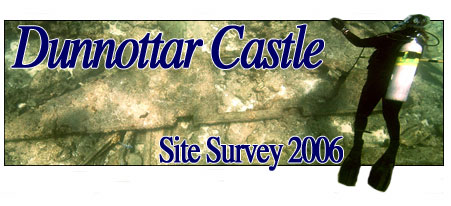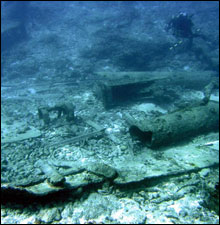
One July 23rd, 2006, the NOAA ship Hiialakai returned to Honolulu following a 28-day research cruise to the Northwestern Hawaiian Islands. The multidisciplinary expedition included six maritime archaeologists with NOAA's National Marine Sanctuary Program conducting non-invasive survey at Kure Atoll and Pearl and Hermes Atoll. The NOAA team included: Brenda Altmeier (Florida Keys NMS), Dr. Kelly Gleason (Pacific Islands Region NMS), Tane Casserley (Maritime Heritage Program NMS), Lindsey Thomas (Hollings program intern from the University of Georgia), Robert Schwemmer (West Coast Region NMS), and Dr. Hans Van Tilburg (Pacific Islands Region NMS, principal investigator). Surveying wreck sites in the Hawaiian archipelago reveals our seafaring history and provides a platform for the message of preservation and comprehensive ocean stewardship. The Dunnottar Castle is one of those opportunities.
 |
| Historic photograph of the ship Dunnottar Castle from the Morton-Waters collection.. (Courtesy San Francisco History Center, SF Public Library) |
|
|
The three-masted 258-foot British iron hulled ship Dunnottar Castle was built in Glasgow, Scotland, in 1874. She was lost at Kure Atoll on July 15th, 1886, while bound for Wilmington, California from Sydney, Australia with a cargo of coal. A malfunctioning chronometer put the ship off course and onto the reef. Though efforts were made to jettison the cargo and repair the damaged hull, the stricken vessel could not be refloated, and the crew abandoned ship for the nearby deserted island. The castaways would have to take charge of their own rescue.
After abandoning the ship, the chief officer and six seamen took one of the boats and made a 52-day passage to Kauai. While they were gone, the majority of the 28-man crew were rescued from the island by the ship Birnam Wood and deposited in Valparaiso, Chile. Meanwhile, back in Honolulu the steamer Waialeale was jointly chartered by the British commissioner in Honolulu and by the Kingdom of Hawaii and sent on a (now redundant) emergency mission to the distant atoll. Only the three dogs which had been left behind, two terriers and a retriever, were there to be rescued. There was more to this trip, however. Hawaiian officials, suspecting that the British might use the occasion to annex the island, shared the expedition expenses and instructed Commissioner James Boyde to take formal possession of Kure Island. Subsequently, a "life protection station" was constructed at Kure for the benefit of future castaways. This station included emergency water tanks, a small house with rainwater drainage system, and coconut trees. Thus, the wreck of the Dunnottar Castle precipitated the Kingdom of Hawaii's official presence at Kure Atoll, the northwestern extreme end of the entire archipelago, our most remote coral atoll.
 |
| NOAA archaeologist records one of several large iron anchors on the wreck site of the Dunnottar Castle.(Photo: NOAA NMSP) |
|
|
Discovery of the site came as a great surprise, for the Kure Atoll refuge staff (State of Hawaii Division of Forestry and Wildlife) came across the wreckage by accident while transiting through the lagoon. Atoll staff radioed the NOAA archaeologists who were surveying two other locations at Kure (New Bedford whaler Parker and the USS Saginaw), and a preliminary survey was initiated. The Dunnottar Castle lies adjacent to a shoal area in the vicinity of the atoll reef, accessible only in calm weather. There can be a distinct thermocline at this location, and the mixing of colder and warmer waters can produce a shimmering effect which detracts from optimum visibility. Coral cover is minimal on the site, but large numbers of fish find safe habitat among the wreckage. The site is alive with the snap, crackle, and pop sounds of shrimp and bi-valves.
 |
| The expanse of iron hull sections at the site. 250-feet of material corresponds to the original length of the ship. (Photo: NOAA NMSP) |
|
|
The initial dive revealed the flattened and broken but nearly complete remains of a late 19th-century tall sailing ship, with iron hull and steel yards and masts. Many of the wooden components, loose materials and organic fabrics have been swept away, but the heavier elements remain. Large sections of iron hull plate, iron frames, rigging, masts, auxiliary steam boiler, keelson, anchors, windlasses, winches, capstans, davits, rudder and steering gear, cargo hatches, bow sprit, hawse pipes, chain locker, ballast stone, deadeyes, chains, stringers, bitts, ladders etc. are fixed in place on the sea bottom. No small or movable artifacts were encountered. Diving the site can be disorienting, for the iron and steel components seem to stretch endlessly across the seafloor.
The site is approximately 250 feet in length, corresponding to the ship's original size. The industrial nature of the artifacts, and the general lack of coral cover, makes the location well suited for standing up to the power of the winter storms and seas which pound the atoll. The wreck of the Dunnottar Castle is a nearly complete assemblage of a late 19th century commercial carrier, an incredible heritage resource from the days of the sailing ships like the Falls of Clyde (Hawaii Maritime Center), Balcalutha (San Francisco Maritime Park), and Star of India (San Diego Maritime Museum), when our maritime commerce was driven by steel masts and canvas, wind power and human hands. Are we only now rediscovering this source of clean energy? Perhaps that's one of the larger lessons from the Dunnottar Castle site.
 |
| NOAA diver above some of the large steel mast sections which lie broken on the seafloor. (Photo: NOAA NMSP) |
|
|
The wreck site today is the home for many species of fish and invertebrates, and like the special natural resources that surround it, the site deserves the protection and preservation provided by the Northwestern Hawaiian Islands Marine National Monument and the State of Hawaii's Department of Land and Natural Resources. Appreciation of this heritage resource, a time capsule from the days of the tall ships, is a part of our larger ocean stewardship.

Additional Resources and Links
Northwestern Hawaiian Islands Marine National Monument
To learn more about the expedition click here.
Hawaii Department of Land and Natural Resources
|





